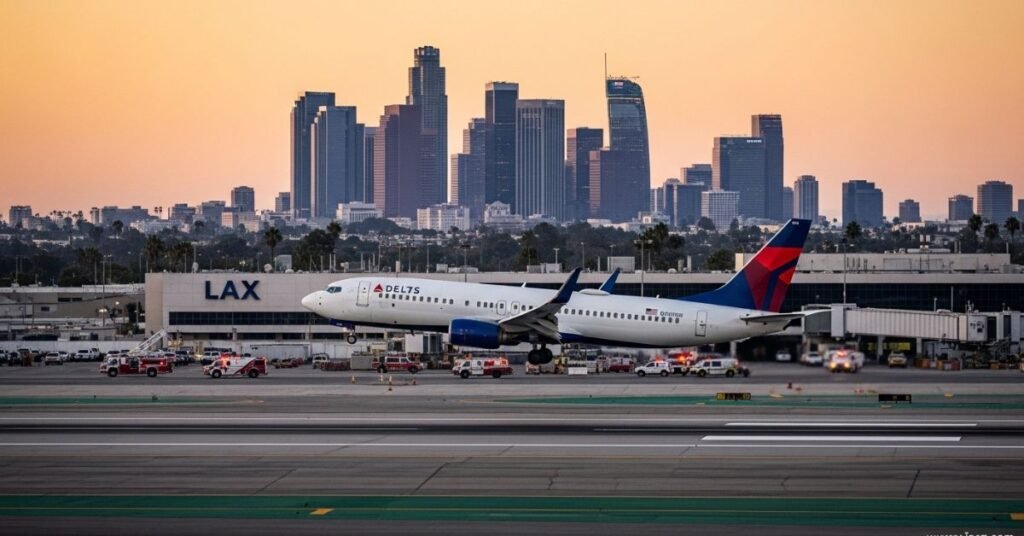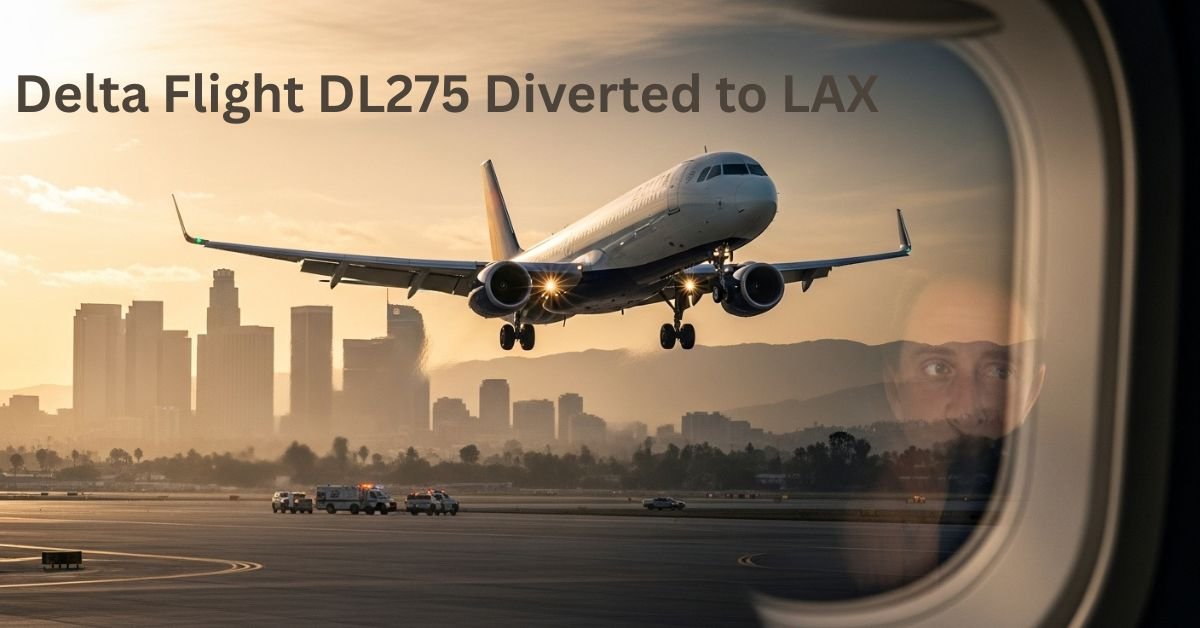In a surprising mid-air development, Delta Flight DL275, a long-haul transpacific flight from Seoul-Incheon to Atlanta, was diverted to Los Angeles International Airport (LAX), raising eyebrows among aviation enthusiasts and passengers alike. This incident, although rare, sheds light on the complex systems that ensure passenger safety at 35,000 feet.
This in-depth article unpacks everything surrounding the diversion, answers key questions, and provides travelers with the essential facts, including industry-standard protocols and what it means when an international flight changes its course.
Flight Overview: Delta DL275 at a Glance
- Airline: Delta Air Lines
- Flight Number: DL275
- Route: Seoul-Incheon (ICN) to Atlanta (ATL)
- Aircraft: Airbus A350-900
- Scheduled Duration: ~13.5 hours
- Passenger Capacity: Approximately 300 passengers
- Status: Diverted mid-flight to LAX
This flight is one of Delta’s premier long-haul international routes, connecting two major global airports and catering to both business and leisure travelers.
Details of the Diversion Incident
Delta Flight DL275 took off without issues from Incheon International Airport, cruising over the Pacific Ocean en route to Atlanta. However, a few hours into the flight, the crew announced an unexpected change: the plane would be landing at Los Angeles International Airport (LAX) instead.
Though early speculation on social media pointed to multiple theories—including weather disruptions and system failures—eyewitness accounts and later confirmations revealed that a medical emergency onboard was the likely cause.
Notable Details:
- Diversion occurred approximately 8 hours into the flight.
- Emergency landing executed smoothly with ATC support.
- Medical personnel met the plane upon arrival at LAX.
Reasons Flights Are Diverted
There are several common reasons a flight might divert from its scheduled route. These are the main options in the case of Delta Flight DL275:
1 Medical Emergencies
Medical incidents remain the most common cause of mid-air diversions. Although first aid is taught to cabin crew, there are situations where prompt medical attention is necessary.
2 Technical Issues
While aircraft like the A350 are advanced and reliable, technical glitches or system faults—even if minor—can justify precautionary landings.
3 Weather Conditions
Changes in jet stream, turbulence, or unexpected storms along the route can lead pilots to reroute to ensure safer landings.
4 Security Concerns
From suspicious passenger behavior to potential threats, airline crew follow a strict security protocol that could result in an emergency landing.
5 Fuel Management
Though rare, fuel-related diversions can happen due to miscalculations, inefficiencies, or unexpected weather patterns.
Why LAX Was Chosen as the Alternate Airport

LAX is one of the largest and most well-equipped airports in the United States, making it a preferred choice for emergency diversions.
Advantages of Diverting to LAX:
- Proximity along the flight path from Asia
- Full-service medical and emergency staff
- Delta operational hub with ground resources
- Runways capable of handling wide-body aircraft
Timeline of Events During the Diversion
A recreated timeline based on passenger and aviation tracking data:
| Time (UTC) | Event Description |
|---|---|
| 06:30 | DL275 departs ICN as scheduled |
| 14:15 | Medical emergency reported onboard |
| 14:25 | Pilot contacts ATC for emergency landing |
| 14:45 | Flight begins descent into LAX airspace |
| 15:10 | Aircraft lands safely at LAX |
| 15:30 | Medical team boards plane to assist passenger |
| 16:00 | Passengers deplane or await rebooking |
Passenger Testimonials: What It Was Like Onboard
Several passengers shared their experiences online, painting a picture of an organized but tense atmosphere.
“The crew was calm, informative, and supportive,” said a business traveler on Reddit.
“They told us it was a medical situation, and that the person needed urgent care. Everyone remained patient.” — Tweeted by user @TravelFlyer.
Passengers were reportedly provided with vouchers, hotel accommodations, and options for connecting flights.
You Might Also Like: United Airlines Flight UA770 Emergency Diversion: Full Details Revealed
Delta Air Lines’ Official Response
Delta’s media relations issued a concise but reassuring statement:
Due to a passenger’s medical condition, Delta Flight DL275 from Incheon to Atlanta was diverted to Los Angeles out of caution. The flight landed without incident. Passengers were supported with onward travel and accommodations as necessary.”
This demonstrates the airline’s adherence to passenger safety protocols and reinforces its reputation for operational excellence.
Aviation Expert Analysis on DL275
Dr. Morgan Wills, Aviation Safety Consultant:
“Diverting a long-haul flight isn’t done lightly. In the case of DL275, diverting to LAX suggests a life-threatening medical situation that couldn’t wait until Atlanta.”
Captain James Tucker, Retired Pilot:
“LAX is ideal because it’s already equipped to handle Delta aircraft and has top-tier medical response teams.”
How Flight Diversions Work: Behind the Scenes
When a pilot makes the decision to divert, it’s more than just changing course. A sophisticated system kicks in:
- ATC Coordination: New route clearance and landing slot
- Emergency Dispatch: Medical or security services prepared on the ground
- Airline Ops Center: Logistics support for passengers and aircraft
- Crew Procedures: In-cabin announcements, safety prep
Airlines like Delta have dedicated teams working in real-time to minimize impact and ensure customer service continuity.
Passenger Rights and Airline Responsibilities
Airlines have clear responsibilities when a flight is diverted, especially internationally:
- Rebooking Flights to final destination
- Providing Meals and Lodging for long delays
- Medical Care Access for emergencies
- Passenger Communication throughout
Passengers are also encouraged to check their travel insurance coverage, especially when traveling internationally.
Impact on Flight Schedules and Airline Logistics
A disruption such as the one experienced by Delta Flight DL275 may have repercussions:
- Crew may exceed legal working hours, causing delays
- Connecting flights could be missed
- Baggage might be delayed or rerouted
Delta’s ability to minimize passenger inconvenience demonstrates a well-oiled operations system.
Comparative History: Other High-Profile Diversions
- Emirates Flight EK203 diverted due to widespread passenger illness
- British Airways BA112 once diverted to Shannon due to cockpit smoke
- United Flight 895 diverted to Tokyo for unruly passenger behavior
Each case had different causes, but shared a common theme: safety first.
What Passengers Should Do During a Diversion
- Stay Calm: Avoid panic; listen to crew instructions.
- Document Everything: Helpful for insurance or complaints.
- Ask for Updates: Stay informed about next steps.
- Claim Vouchers and Meals: Know what you’re entitled to.
- Keep Essentials Handy: Medications, phone charger, ID.
The Role of Air Traffic Control in Diversions
Air Traffic Control (ATC) plays a crucial role in any diversion scenario:
- Quickly identifies nearest viable airports
- Clears emergency landings and reroutes other traffic
- Coordinates with emergency responders
Without ATC coordination, a safe landing at an alternate airport like LAX would be nearly impossible.
FAQs – People Also Ask
Why did Delta Flight DL275 divert to LAX?
Delta Flight DL275 was diverted due to a medical emergency involving a passenger who required immediate attention.
Is DL275 a safe flight?
Yes. Delta DL275 has a strong safety record, and the decision to divert demonstrates rigorous safety protocols.
Do passengers get compensation for flight diversions?
Not always. Compensation depends on the reason. For medical or safety reasons, airlines offer support but not necessarily refunds.
How do airlines decide where to divert a flight?
Pilots consult with dispatch and ATC to identify the closest airport with appropriate infrastructure and support.
Can I rebook or change my ticket after a diversion?
Yes. Airlines like Delta usually assist passengers in rebooking or rerouting at no extra cost.
Final Thoughts
The diversion of Delta Flight DL275 to LAX might have caused momentary disruption, but it reflects the maturity and precision of modern aviation safety systems. With quick decisions, expert handling, and responsive customer service, the situation was controlled efficiently.
As passengers, it’s important to understand that diversions—while inconvenient—are ultimately about protecting lives. And in that regard, Delta Air Lines delivered on its commitment to excellence.
Always fly prepared, stay informed, and remember: when unexpected detours occur at 35,000 feet, it’s the safety net that matters most.
